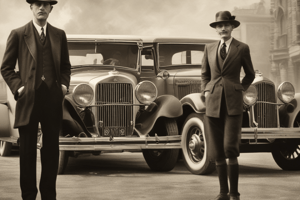Podcast
Questions and Answers
What was the primary reason why economic problems in the 1920s were initially hidden?
What was the primary reason why economic problems in the 1920s were initially hidden?
- The strong agricultural sector
- The decline in unemployment rates
- The rise of consumer spending on credit (correct)
- The government's intervention in the economy
Which group was most affected by the economic downturn in the early 1920s?
Which group was most affected by the economic downturn in the early 1920s?
- Small business owners
- Bankers
- Industrial workers
- Farmers (correct)
What was the primary cause of the stock market crash in 1929?
What was the primary cause of the stock market crash in 1929?
- A surplus of shares on the market (correct)
- Overproduction by industries
- A rise in interest rates
- A decline in consumer spending
Why did President Hoover respond cautiously to the Great Depression?
Why did President Hoover respond cautiously to the Great Depression?
What was the main goal of the Reconstruction Finance Corporation (RFC)?
What was the main goal of the Reconstruction Finance Corporation (RFC)?
What was the primary consequence of the Hawley-Smoot Tariff?
What was the primary consequence of the Hawley-Smoot Tariff?
What was the term used to describe the central and southern Great Plains during the 1930s?
What was the term used to describe the central and southern Great Plains during the 1930s?
What was the outcome of President Hoover's veto of the bill providing for early payment of bonuses to WWI veterans?
What was the outcome of President Hoover's veto of the bill providing for early payment of bonuses to WWI veterans?
Why did African Americans and Mexican Americans face an especially difficult time during the Great Depression?
Why did African Americans and Mexican Americans face an especially difficult time during the Great Depression?
What was the main goal of the Securities Exchange Commission (SEC)?
What was the main goal of the Securities Exchange Commission (SEC)?
What was a significant flaw of the Social Security Act?
What was a significant flaw of the Social Security Act?
What was the main concern of conservatives (Republicans) regarding the New Deal?
What was the main concern of conservatives (Republicans) regarding the New Deal?
What was the primary purpose of the Tennessee Valley Authority?
What was the primary purpose of the Tennessee Valley Authority?
What was the main achievement of the WPA?
What was the main achievement of the WPA?
What was the significance of the Civilian Conservation Corps?
What was the significance of the Civilian Conservation Corps?
What was the main impact of radio on American culture in the 1920s and 1930s?
What was the main impact of radio on American culture in the 1920s and 1930s?
What was the response of Americans to escapist films in the 1930s?
What was the response of Americans to escapist films in the 1930s?
How did New Deal programs affect capitalism?
How did New Deal programs affect capitalism?
What was a significant consequence of the demand for automobiles in the 1920s?
What was a significant consequence of the demand for automobiles in the 1920s?
What was a primary reason for nativists' opposition to immigration?
What was a primary reason for nativists' opposition to immigration?
What was a notable difference between urban and rural lifestyles in the 1920s?
What was a notable difference between urban and rural lifestyles in the 1920s?
What was the primary focus of the literature produced during the Harlem Renaissance?
What was the primary focus of the literature produced during the Harlem Renaissance?
What was the Harlem Renaissance a celebration of?
What was the Harlem Renaissance a celebration of?
What was Jazz music characterized as?
What was Jazz music characterized as?
Flashcards are hidden until you start studying
Study Notes
Factors Hiding Economic Problems in the 1920s
- Americans' excessive purchasing of consumer goods on credit contributed to hiding economic problems
- Many farmers experienced an early depression in the 1920s
The Business Cycle
- The US economy was in the expansion phase of the business cycle during the 1920s
The Stock Market Crash
- Black Tuesday occurred on October 29, 1929, when stock prices sharply fell
- The stock market crashed in 1929 due to a surplus of shares on the market, causing prices to plummet
- The crash affected banks initially, as numerous depositors tried to withdraw their money simultaneously
International Reactions
- European countries reacted to the Hawley-Smoot Tariff by taxing American imports
Presidential Response
- President Hoover responded cautiously to the Great Depression, believing the business cycle would self-correct
- He believed in volunteerism, which failed as individuals and businesses acted in their own self-interest
Economic Theories
- Trickle-down economics holds that benefits given to banks and large businesses will benefit smaller businesses and consumers
- This theory did not work in the 1930s
Government Response
- The Reconstruction Finance Corporation (RFC) was established to provide loans to banks, enabling them to stimulate economic activity
- The RFC was a response to the growing economic crisis
Environmental Disasters
- The Dust Bowl referred to the central and southern Great Plains during the 1930s, which suffered from drought and dust storms
- The Dust Bowl was caused by intensive farming practices that removed protective grasses
The Bonus Army
- President Hoover's veto of a bill providing early payment of bonuses to WWI veterans led to the Bonus Army marching on Washington, D.C.
Minority Groups
- African Americans and Mexican Americans faced discrimination when competing for a limited number of jobs during the Great Depression, making their situation even more difficult
Studying That Suits You
Use AI to generate personalized quizzes and flashcards to suit your learning preferences.




